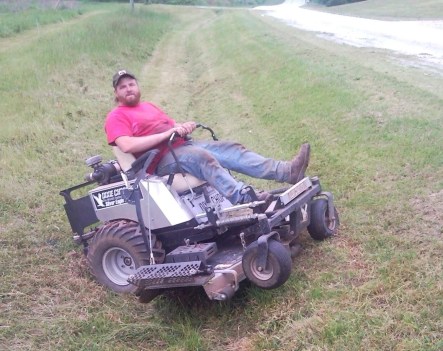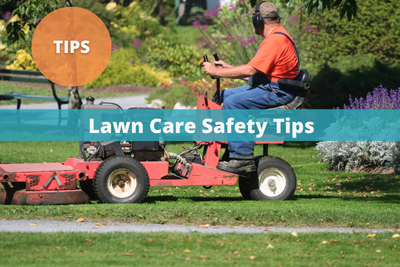As more and more people choose to mow their own grass these days, one overlooked aspect of caring for your lawn is attention to safety.
You’ve probably heard some of your neighbors’ mowing and landscaping horror stories:
Isaiah Adams of Toledo, Ohio, posted on the Joy of Mowing Facebook page about the time he hit a tree stump that had been covered in leaves.
“Needless to say it stopped my stander dead in its track and threw me off the mower in front of the worst 5 o’clock rush hour traffic you’ve ever seen,” Isiah said.
Christopher Sutton of Lenoir City, Tennessee ran over a four-inch stump that bent his lawnmower blade and locked down the spindle bolt. “I thought I’d never get that thing backed out to change the blade…always check your area and remember where the stumps are,” Christopher said.
Then there are examples of people running over sprinkler heads, garden hoses, and other debris in the grass.
D Dizzie Druck of Midale, Saskatchewan, remembers his mower “throwing a chunk of cement right through a neighbor’s PVC fence.”
“I’ve come close to slipping and both my feet going under the deck while mowing on a slope,” said Mitch Brooks of Monterey, Louisiana. “Luckily, I stopped before being hurt.”

Best Practice Safety Lessons
Follow these tips from landscaping pros and independent dealers to stay safe in the yard:
Even before you get out the lawnmower and crank up the engine on your power equipment for that day’s job, it is always good practice to walk your property. You’re looking for any obstacles, loose debris, or other impediments that may cause injury or damage. Pick it up and clear it away before starting to mow.
Personal Protection
While out in the yard, use a head-to-toe safety checklist:
- Hats and helmets to protect against the sun or when using chainsaws on trees and tree limbs
- Eye protection, such as safety glasses and goggles especially when using tillers, trimmers, and lawnmowers
- Hearing protection, such as earplugs and ear muffs to reduce decibel exposure from leaf blowers and other small engines
- Cut-resistant chaps or leg protectors when using chainsaws
- Sturdy shoes or high-cut footwear with toe caps and reinforced, non-skid soles
Operational Safety Practices
A common explanation for injuries that result from lawnmowers and power equipment is that people cut corners. So, the simplest way to avoid them is to keep hands and feet away from mower blades while in operation. Every time you need to get near a turning blade: cut the engine.

Be aware of the dangers posed by steep and slippery slopes, retaining walls, and drop-offs that could result in mowing equipment overturns.
One often ignored source of good safety information that is available at your fingertips is the owner’s manual that comes with your lawn mower and power equipment.
“There’s a lot of information in the manuals that would help [consumers] about basic operation,” said Bryan Lindner, the owner and operator of Ephrata Saw and Mower in Ephrata, Washington.
Both the U.S. and Canadian governments regulate workplace safety for landscapers. You can go to agency web sites to see those checklists and borrow advice for your own lawn and landscaping habits.
And if all else fails?
You can always heed the advice of Paul Delancey, owner-operator of Delancey’s Lawncare in Palm Bay, Florida:
“Hire a lawn guy.”

